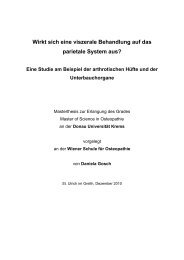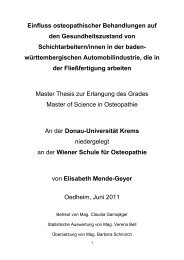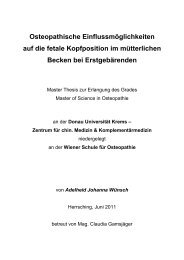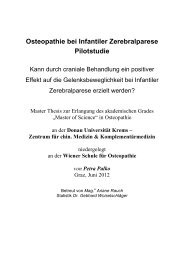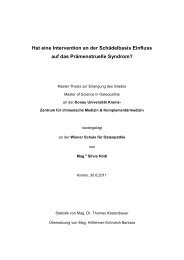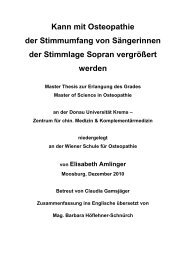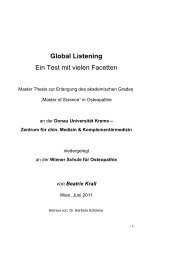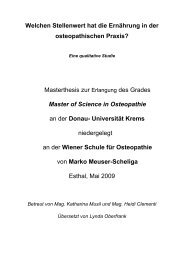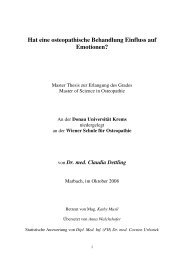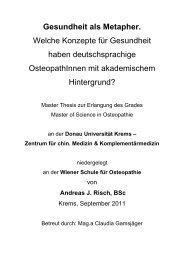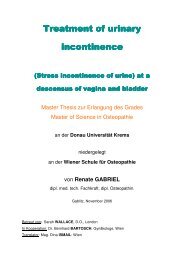Comparison between CV4 and EV4 - Osteopathic Research
Comparison between CV4 and EV4 - Osteopathic Research
Comparison between CV4 and EV4 - Osteopathic Research
Create successful ePaper yourself
Turn your PDF publications into a flip-book with our unique Google optimized e-Paper software.
17<br />
2.4 Autonomic nervous system (ANS)<br />
2.4.1 General:<br />
The parameters measured in this study (skin-conductance, skin-temperature,<br />
pulse-rate, <strong>and</strong> respiratory frequency) are body functions that are controlled,<br />
regulated <strong>and</strong> fine-tuned through the autonomic nervous system. The ANS is to<br />
a large extent independent from our will; however, numerous combinations <strong>and</strong><br />
interrelationships <strong>between</strong> the somatic <strong>and</strong> the autonomic nervous system exist.<br />
The central ANS consists of parts of the cortex, thalamus, hypothalamus, limbic<br />
system <strong>and</strong> reticular formation.<br />
In the inter brain, the third ventricle divides the thalamus into two halves; the<br />
hypothalamus lies at the base of the third ventricle. The thalamus acts as<br />
switchboard to the cortex. The thalamus is also known as the “door to<br />
consciousness” as all information from the environment <strong>and</strong> the senses flow<br />
through its core. These afferent senses (with the exception of odour) meet in the<br />
thalamus, are judged, weighted, filtered, associated with a feeling <strong>and</strong> finally<br />
further directed; but only a fraction of this process reaches the consciousness.<br />
The thalamus is an important integration <strong>and</strong> co-ordination organ.<br />
The hypothalamus is with its neural, neuro-secretal <strong>and</strong> hormonal function the<br />
single most important regulation centre of all the autonomic functions that<br />
guarantee the homeostasis necessary for life. It coordinates the endocrine <strong>and</strong><br />
the ANS.<br />
The central ANS controls the peripheral ANS, consisting of the sympathetic <strong>and</strong><br />
parasympathetic. The sympathetic nerve increases performance levels under<br />
stress <strong>and</strong> emergency situations, as it activates organ functions that are necessary<br />
for intellectual <strong>and</strong> physical work. The parasympathetic serves the metabolism,<br />
regeneration, <strong>and</strong> the gathering of physical reserves. Its activity is increased in<br />
rest <strong>and</strong> sleep; however, a functional synergy exists <strong>between</strong> both parts of the<br />
ANS which affects the whole organism.<br />
Margit Grill / 2006



